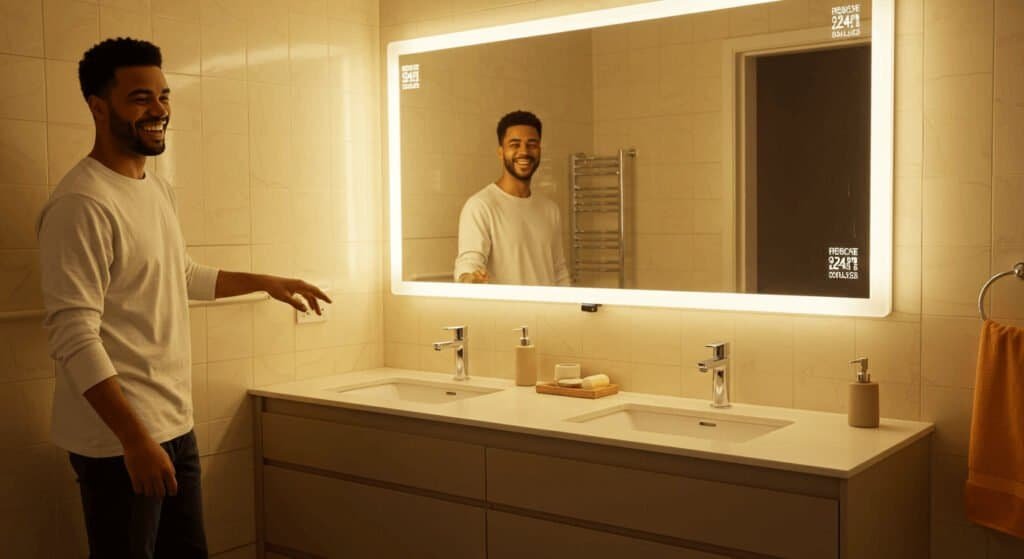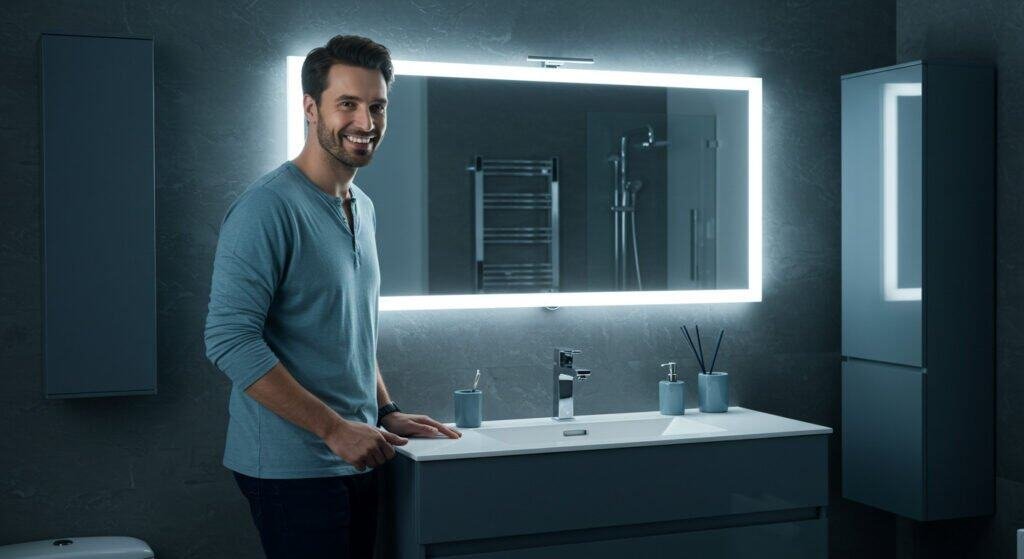Are lighted mirrors worth it? Poor lighting ruins your daily routine, creating shadows that make grooming tasks frustrating and potentially unsafe. Traditional bathroom mirrors force you to rely on overhead fixtures that cast unflattering shadows across your face.
Lighted mirrors provide exceptional value through superior illumination, energy efficiency, and modern functionality that transforms your daily experience while delivering long-term cost savings and enhanced property value.
Understanding the specific benefits and considerations will help you make an informed decision about this important home improvement investment.
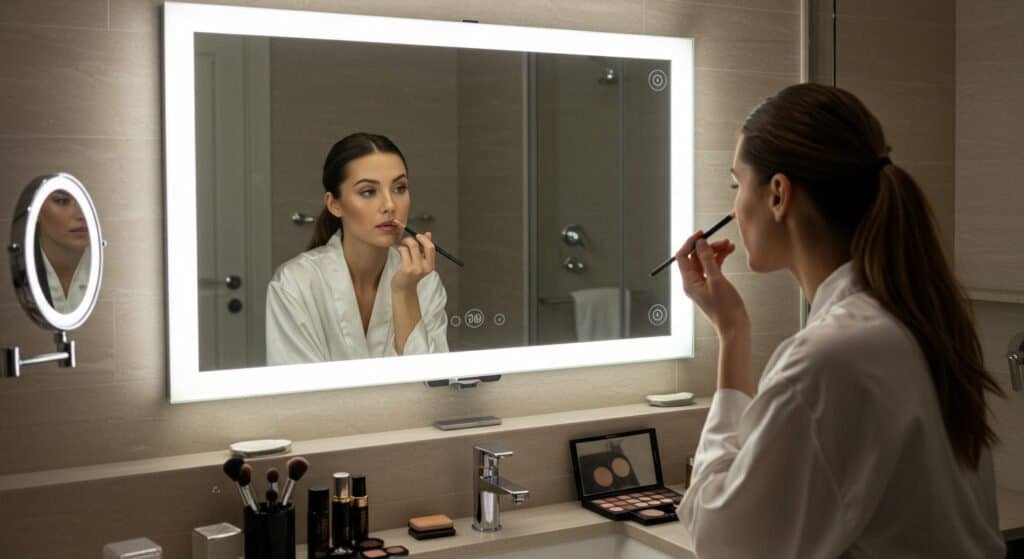
Are Lighted Mirrors Good in the Bathroom?
The bathroom has very unique conditions in which a led bathroom mirror is very nice to have. The humidity, steam, and the light that changes over the course of the day—these all make it a unique environment.
Led light mirror vanity options excel in bathroom applications because they provide consistent, even illumination regardless of external lighting conditions while offering anti-fog technology that maintains clear visibility during and after hot showers.
A modern bathroom vanity mirror with integrated LED addresses several bathroom-specific challenges all in one shot. The consistent light output eliminates those hard shadows caused by overhead fixtures. The glass stays fog free no matter what condition you throw at it.
They also can have the ability to adjust the color temperature so you can have a warmer tone if you’re trying to relax, a cooler tone if you’re working and you need to see your face better. You have that ability to change it. Then, of course, the way they’re built, because they are built so that they are moisture-resistant with the proper IP rating will give them the ability to perform in that environment for years and years.
What Are the Disadvantages of LED Mirrors?
Are there any downsides or limitations? In order to have realistic expectations and to understand how you’re going to use it, you need to know where it doesn’t work.
The primary disadvantages include higher initial costs, potential installation complexity, limited repair options, and dependency on electrical connections that may require professional installation.
Modern lighted mirrors for bathrooms typically cost significantly more than traditional glass mirrors, with prices ranging from moderate to premium depending on features and size. Installation often requires electrical work, particularly for hardwired models, which adds to the overall investment.
When the LED mirror components do fail, you’re probably going to have to replace the whole mirror not just a bulb or a fixture. The integrated electronics they have built into them can, sometimes, be sensitive to any power surges or fluctuations. You have no option then but to replace the entire assembly. Some people also notice that if the backlight mirror is not put in the right place, you’ll get a glare off of it which can be problematic. Again, it’s drawing electricity, so there’s an electrical consumption cost associated with it.
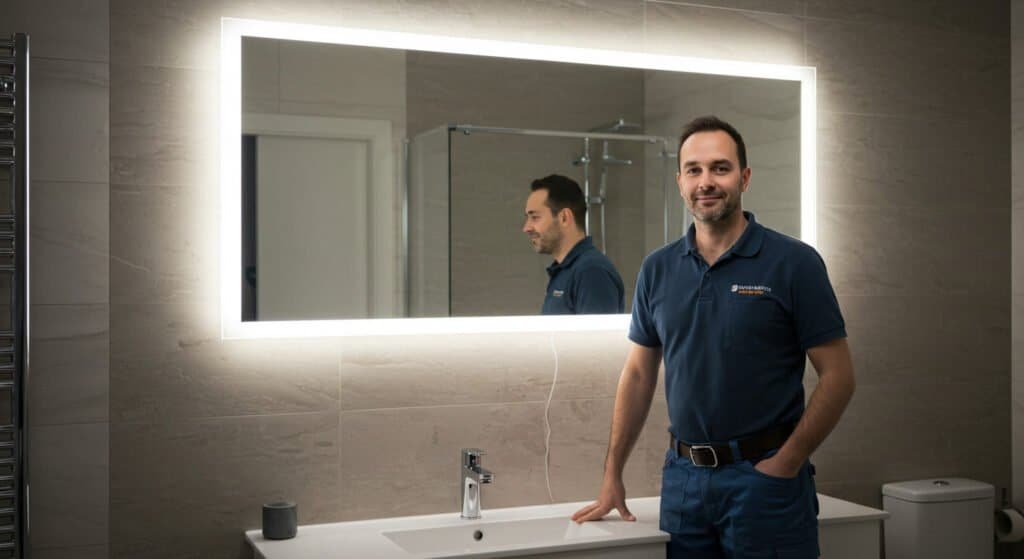
What Type of Mirror is Best for Bathrooms?
When deciding on which mirror you want to use, it all really depends on your exact needs, the constraints of your space and, of course, what you’re trying to accomplish. However, when it comes to modern installations, the LED bathroom mirror is almost without question the way to go.
LED bathroom mirrors represent the best overall value for most bathroom applications due to their combination of superior lighting, durability, anti-fog capabilities, and energy efficiency compared to traditional alternatives.
When comparing options, rectangular bathroom mirrors with LED integration offer the most versatile solution for standard bathroom layouts. Small bathroom mirror installations benefit particularly from LED technology because the integrated lighting eliminates the need for additional fixtures in cramped spaces. Lighted vanity mirrors provide targeted illumination that enhances functionality without overwhelming compact areas.
If you’re stuck with a small space there are mirrors with lights and storage. In bigger spaces you can go with a bathroom mirror with lights and storage combo to really maximize what you can get out of that space. For those powder rooms which have excellent natural light, a mirror with no lights may be more than adequate. But, in general, LED is the way to go.
Which is Better: Front Lit or Back Lit Mirror?
Whether you get a front-lit mirror or backlit one makes a serious difference in the functionality and aesthetic in your bathroom space.
Front-lit mirrors provide superior task lighting with direct illumination, while backlit mirrors offer ambient lighting with reduced glare, making the choice dependent on your primary usage requirements.
Front-lit lighted makeup mirror designs excel for detailed grooming tasks because they direct light toward your face, eliminating shadows and providing optimal visibility for precise work. These wall mirror with lights configurations typically offer brighter, more focused illumination suitable for shaving, makeup application, and other detailed tasks.
Backlit mirror designs create a softer, more atmospheric lighting effect that works well for general bathroom ambiance while reducing harsh reflections. But, for night time front-lit lights pierce your eyes. It’s harsh on the eyes. Backlit is much easier to deal with at night. It also has a really cool, modern, floating looking that can look fantastic in a modern bathroom. A lot of the top end models of these makeup mirror with lights now use front lights and back lights, and so you can swap and choose depending on the time and situation.

Is a Lighted Mirror Enough Light for a Bathroom?
Determining whether a lighted vanity mirror provides sufficient illumination requires understanding your bathroom’s size, layout, and usage patterns.
A quality LED bathroom mirror typically provides adequate lighting for most grooming tasks, though larger bathrooms may benefit from supplementary vanity lights or ambient lighting for comprehensive illumination.
Best lighted bathroom mirror models produce between 800-1200 lumens, which meets or exceeds the recommended lighting levels for bathroom vanity areas. That’s kind of all you need, right? This is the normal western world use case. You’re brushing your teeth, doing your makeup, doing the shaving or whatever you’re doing in a residential bathroom. When we’re talking about room mirror ideas for a bigger space or a commercial application, you’ll often see more of these vanity lights going up on the mirror. People are trying to create even more dramatic light in that case.
Then, you’ve got the 24-inch x 32-inch mirror. The effectiveness will depend on mirror size. A big mirror like that 48-inch x 36-inch led bathroom mirror, is going to have a lot of coverage. Then, position of the mirror in relation to other lights in the room. You also have to think about whether or not the integrated lighting is going to go along with the rest of the light in the bathroom.
How Long Do LED Bathroom Mirrors Last?
Understanding the lifespan of led mirrors helps evaluate their long-term value proposition and maintenance requirements.
Quality LED bathroom mirrors typically last 15-20 years with normal use, offering 50,000+ hours of LED life while maintaining consistent performance throughout their operational period.
The longevity of lighted bathroom mirror cabinet systems depends on several factors including LED quality, manufacturing standards, and environmental conditions. Premium mirrors with black frame designs often incorporate higher-grade components that extend operational life, while budget models may experience shorter lifespans.
The LED components themselves rarely fail completely but may experience gradual dimming over time. Environmental factors such as humidity control, temperature fluctuations, and electrical stability significantly impact longevity. Regular cleaning and proper ventilation help maximize the lifespan of these mirrors. When considering replacement costs, the extended operational life of quality LED mirrors often justifies their higher initial investment compared to traditional lighting solutions that require frequent bulb replacements.
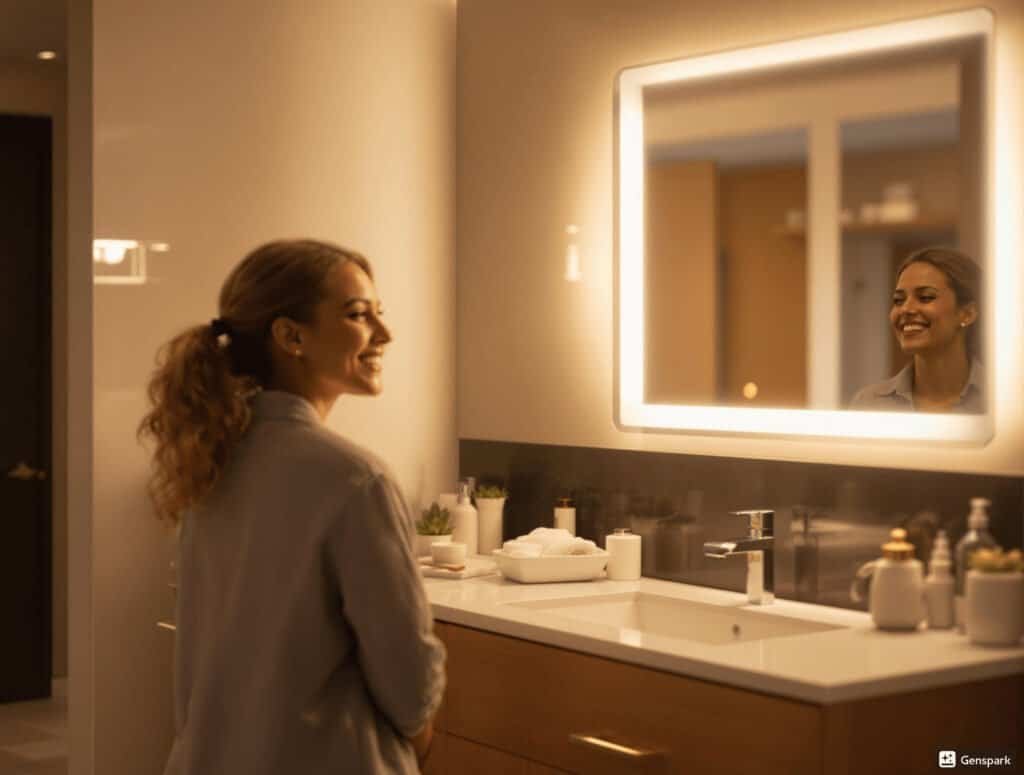
Do LED Bathroom Mirrors Need to be Plugged In?
Power requirements for lighted makeup mirror installations are driven by design specifications and where you intend to mount it.
LED bathroom mirrors are available in both plug-in and hardwired configurations, with hardwired models requiring professional installation but offering cleaner aesthetics and more reliable connections.
Plug-in lighted vanity mirrors offer easier installation and flexibility for renters or temporary installations, requiring only a nearby electrical outlet. Models equipped with built-in cord management offer a cleaner look, as well as cordless convenience for relocating the mirror. Hardwired installations present a more permanent, professional appearance with no visible cords or plugs. However, you will need to do electrical work.
Lighted bathroom mirror cabinet systems often incorporate hardwired connections due to their larger size and integrated storage features. Your decision about whether to choose plug-in or hardwired should hinge on how you want to install the mirror, your electrical access, and whether you might want to move the mirror in the future. They both perform exactly the same from a light perspective and how they function.
Conclusion
Lighted mirrors deliver exceptional value through superior functionality, energy efficiency, and long-term durability that justifies their investment cost for most bathroom applications.
- Clik here to know What Is Copper Free Mirror?
- If you donot know how too choose the right bathroom height click here.
- Know more about LED bathroom mirror Problems
- Clik here to know why Touch Sensor Mirror Not Working
- Clik here to know What Are Standard Vanity Mirror Sizes?
- Clik here to know Why Are Mirrors So Expensive?
- Clik here to know Do LED Mirrors Need Electricity?
- Clik here to know Is a Lighted Mirror Enough Light for a Bathroom?
- Find out 10 Common LED Bathroom Mirror Problems Click Here

